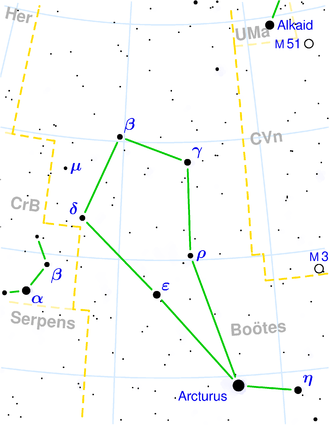NGC 5707
| Galaxy NGC 5707 |
|
|---|---|

|
|
| Image taken with the Hubble Space Telescope | |
| AladinLite | |
| Constellation | Bear keeper |
|
Position equinox : J2000.0 , epoch : J2000.0 |
|
| Right ascension | 14 h 37 m 30.8 s |
| declination | + 51 ° 33 ′ 43 ″ |
| Appearance | |
| Morphological type | Sab sp |
| Brightness (visual) | 12.5 mag |
| Brightness (B-band) | 13.3 mag |
| Angular expansion | 2.5 ′ × 0.5 ′ |
| Position angle | 35 ° |
| Surface brightness | 12.7 mag / arcmin² |
| Physical data | |
| Redshift | 0.007378 +/- 0.000010 |
| Radial velocity | 2212 +/- 3 km / s |
|
Stroke distance v rad / H 0 |
(104 ± 7) · 10 6 ly (32.0 ± 2.2) Mpc |
| history | |
| discovery | Lewis A. Swift |
| Discovery date | 1878 |
| Catalog names | |
| NGC 5707 • UGC 9428 • PGC 52266 • CGCG 273-015 • MCG + 09-24-23 • LDCE 1043 NED016 | |
NGC 5707 is an edge-on spiral galaxy in the constellation Bear Keeper (Bootes). It is located around 2 arc minutes west-southwest of the star HD 128941 ( SAO 29224 , 7 mag). Immediately on its northern edge is another, much less bright galaxy ( PGC 52269 ), which is likely to be a background object .
The galaxy was discovered in 1878 by the astronomer Lewis A. Swift using his 16-inch lens telescope and was later included in his New General Catalog by Johan Dreyer .
